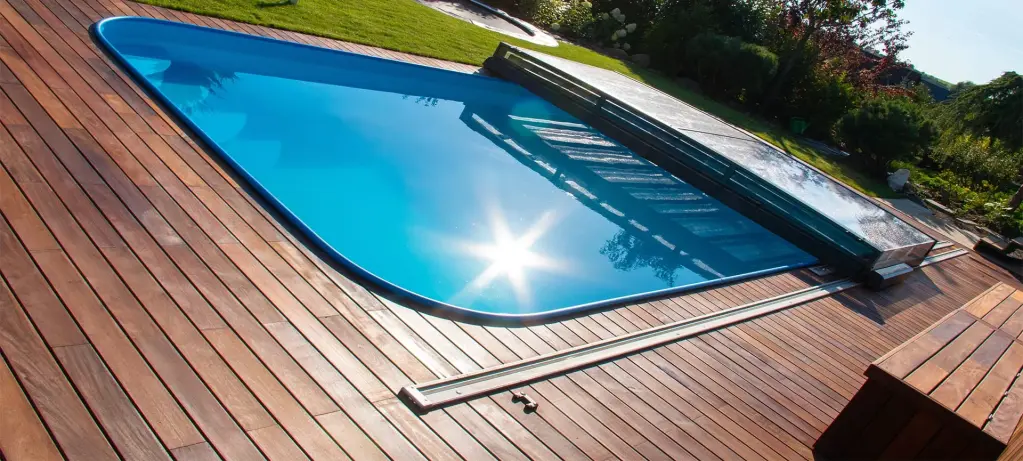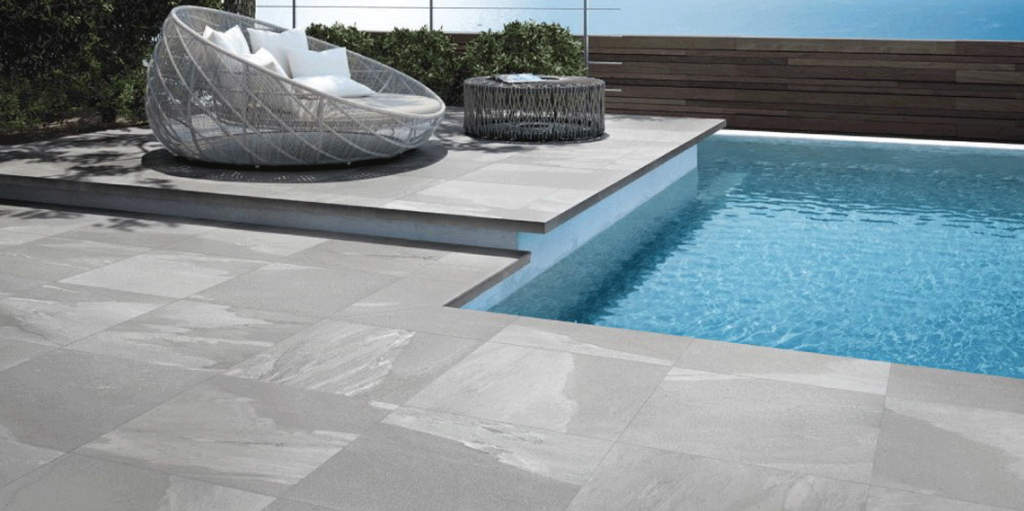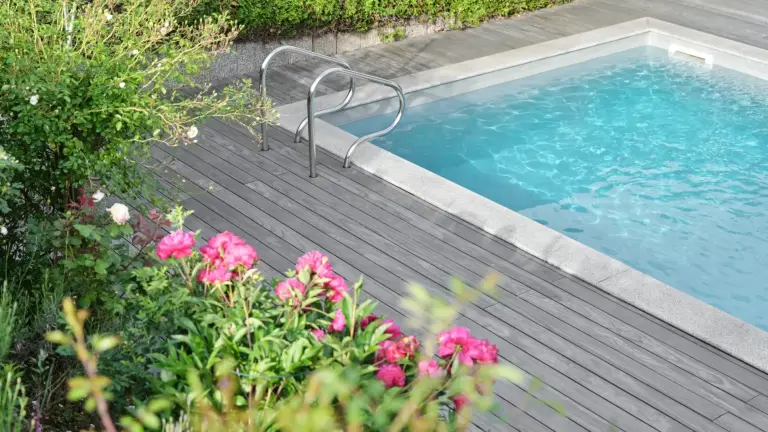Your swimming pool is more than just a place to cool off during a humid Pennsylvania summer; it’s the heart of your backyard, a stage for family gatherings, quiet relaxation, and lasting memories. The surface that frames this centerpiece, your pool deck, plays a role just as critical as the water itself. The right pool deck material not only elevates the beauty of your entire outdoor living space but also provides a safe, durable foundation for all the activities that happen around it.
For homeowners here in Pennsylvania, our distinct four-season climate presents a unique set of challenges. From the sweltering heat of July to the deep freezes of January, your pool deck must be engineered to endure. This guide is designed to be your comprehensive resource for navigating the world of inground pool decks. We will explore the leading material options in-depth, weigh their practical pros and cons, and arm you with the knowledge to select a surface that perfectly aligns with your home’s aesthetic, your family’s lifestyle, and your budget. By the end, you’ll feel confident in creating a poolside space you’ll cherish for countless seasons to come.

Understanding Your Options: A Deep Dive into Pool Deck Materials
When it comes to inground pool decks, the choices can seem overwhelming. Each material offers a unique blend of aesthetics, performance, and cost. Let’s break down the most popular and practical choices for Pennsylvania homeowners, exploring the nuances that make each one a contender for your backyard project.
Poured Concrete: The Versatile Classic
Poured concrete has long been the go-to choice for pool decks, and for good reason. It offers a clean, seamless surface that is both functional and, in today’s market, surprisingly customizable. It serves as a reliable and budget-friendly foundation for any poolside design.
- Pros:
- Unbeatable Affordability: On a square-foot basis, poured concrete remains one of the most cost-effective pool deck materials, allowing you to allocate more of your budget to other features.
- Solid Durability: When professionally installed with proper reinforcement and control joints, and diligently sealed, a concrete deck is built to withstand our demanding climate.
- A Canvas for Creativity: The era of the plain gray slab is over. Modern techniques allow concrete to be a chameleon, perfectly matching your design vision.
- Cons:
- Susceptibility to Cracking: The primary nemesis of concrete in our region is the freeze-thaw cycle. Over time, temperature fluctuations can cause hairline cracks or more significant fissures to develop.
- Heat Absorption: Standard, uncolored concrete can become uncomfortably hot under the peak summer sun, sending you hopping for your flip-flops. Lighter colors or coatings can mitigate this.
- Slipperiness Risk: A smoothly troweled concrete surface is a major slip hazard when wet. A broom finish or textured topcoat is non-negotiable for safety.
Beyond the Gray Slab: Modern Concrete Finishes
The true magic of concrete lies in its finishing options. A skilled contractor, like the team at FS Landscaping Contractors, can transform this simple material into a work of art.
- Stamped Concrete: This is the most popular decorative option. A pattern is stamped into the fresh concrete to mimic the look of more expensive materials like slate, cobblestone, flagstone, or even wood planks. Combined with integral color or stains, the result can be remarkably convincing.
- Stained Concrete: Acid or water-based stains can be applied to new or existing concrete to give it a rich, translucent, marbled color. This is a great way to add character and depth.
- Brushed Finish: The simplest and most common safety feature is a broom-finished surface. Before the concrete fully cures, a special broom is dragged across it, creating fine lines that provide excellent grip for wet feet.
- Exposed Aggregate: This finish involves removing the top layer of cement paste to reveal the smooth, small stones (aggregate) within the mix. It creates a beautiful, pebble-like texture that is naturally slip-resistant.
Pavers: Interlocking Elegance and Practicality
For those seeking a more structured, upscale appearance, pavers are an exceptional choice. Composed of individual units set on a bed of sand and gravel, they create a flexible yet stable surface that offers both aesthetic charm and practical advantages.
- Pros:
- Superior Aesthetics: Pavers provide a timeless, sophisticated look with endless design possibilities through various shapes, colors, and laying patterns like herringbone or running bond.
- The Ease of Repair: This is a major advantage in Pennsylvania. If a few pavers crack or become stained, a contractor can simply lift out the damaged units and replace them, seamlessly restoring your deck.
- Excellent Drainage: The joints between pavers, typically filled with polymeric sand, allow water to permeate into the base layer, preventing puddles and reducing runoff.
- Cons:
- Higher Initial Investment: The material cost and the labor-intensive installation process make pavers a more expensive option than poured concrete.
- Maintenance Needs: The joints between pavers can be a place for weeds or moss to grow. Using polymeric sand and regular cleaning can prevent this.
- Potential for Settling: If the base is not prepared meticulously, pavers can shift or settle over time, creating an uneven surface that may become a tripping hazard.
Types of Pavers: Concrete, Clay, and Stone
- Concrete Pavers: The most common and versatile type, manufactured in a huge array of styles and colors. They are durable, precisely uniform, and offer the best value.
- Clay Pavers (Brick): For a classic, traditional look, nothing beats genuine brick pavers. They offer a warm, timeless color that doesn’t fade over time.
- Natural Stone Pavers: Materials like travertine or bluestone can be cut into uniform paver shapes, combining the beauty of natural stone with the installation benefits of a paver system.
Natural Stone: The Pinnacle of Luxury
For a pool deck that makes an undeniable statement of luxury and connection to the earth, natural stone is in a class of its own. Materials like travertine, bluestone, and flagstone are quarried directly from the earth, meaning the natural veining, color variations, and texture of real stone create a one-of-a-kind masterpiece that cannot be replicated.
- Pros:
- Unmatched Beauty: The natural veining, color variations, and texture of real stone create a one-of-a-kind masterpiece that cannot be replicated.
- Incredible Longevity: Natural stone is the most durable option available. It has already existed for millions of years and will easily outlast any other feature of your home with proper care.
- Naturally Cool Surface: Travertine, a type of limestone, is famous for its ability to stay remarkably cool to the touch, even in direct summer sun—a major benefit for bare feet.
- Cons:
- Significant Investment: Natural stone is the most expensive pool deck material, reflecting the cost of quarrying, cutting, transportation, and skilled installation.
- Potential for Slipperiness: Some stone types, particularly those with a very smooth or honed finish, can be slippery when wet. Choosing a stone with a natural cleft or tumbled texture is crucial for safety.
- Requires Sealing: Most natural stones are porous and should be sealed to protect against staining from spills and damage from pool chemicals or winter salts.
Alternative Pool Deck Materials: Wood and Composites
While stone and concrete dominate, other materials also deserve consideration.
- Wood Decking: A classic wood deck offers a warm, natural aesthetic that blends beautifully with a landscaped yard. Pressure-treated pine is the budget option, while cedar and redwood offer enhanced natural resistance to rot and insects. However, wood requires significant annual maintenance in a pool environment—sanding, staining, and sealing are essential to prevent rot, splinters, and discoloration.
- Composite Decking: Made from a blend of wood fibers and recycled plastics, composite decking is the low-maintenance answer to wood. It won’t rot, warp, or splinter, and it never needs staining. The downsides include a higher upfront cost, a tendency to get hotter in the sun than most other materials, and an appearance that, while improving, can still look less authentic than real wood.
Pool Deck Material Comparison Table
| Feature | Poured Concrete | Pavers | Natural Stone | Composite Decking |
| Initial Cost | Low | Medium | High | High |
| Durability | Good | Very Good | Excellent | Very Good |
| Maintenance | Low | Medium | Medium | Very Low |
| Aesthetics | Good-Excellent | Excellent | Excellent | Good-Very Good |
| Heat Resistance | Fair-Good | Good-Excellent | Excellent | Poor-Fair |
| Slip Resistance | Good (with texture) | Very Good | Good-Excellent | Very Good |
Crucial Factors for Your Pennsylvania Pool Deck
Beyond choosing a material, several environmental and functional factors specific to our region must be addressed to ensure your deck’s longevity and safety.
- The Freeze-Thaw Cycle: This is the single most destructive force for hardscaping in our climate. Water seeps into pores and cracks, freezes, expands by about 9%, and exerts immense pressure. This is why a proper base for pavers is critical, as it allows for slight movement without damage. For concrete and stone, proper sealing is the best defense, acting as a raincoat to prevent water penetration in the first place.
- Slip Resistance: Safety is paramount. A pool deck is, by definition, a wet surface. Every material you consider should have a textured, non-slip finish. Ask your contractor about the material’s “coefficient of friction” (COF); a higher rating means better grip.
- Heat Reflectivity: Think about a hot July afternoon. A dark bluestone or dark composite deck can become hot enough to be genuinely uncomfortable on bare feet. Lighter-colored materials, like light gray pavers or tan travertine, reflect more solar radiation and stay significantly cooler.
- Coping Integration: Coping is the finished edge around the pool’s shell. It’s what you hold onto when you’re in the water or sit on at the pool’s edge. Your chosen deck material must integrate smoothly with your coping. This can be achieved with bullnose (rounded edge) pavers, cantilevered concrete that extends over the pool edge, or custom-cut natural stone pieces that match the deck.

Conclusion: Your Perfect Pool Deck Awaits
Choosing the right pool deck material is a significant decision that impacts the beauty, safety, and longevity of your entire backyard oasis. It’s a balance of budget, aesthetic desires, and practical considerations for our unique Pennsylvania climate. From the versatile and creative options of stamped concrete to the timeless elegance of pavers and the unparalleled luxury of natural stone, there is a perfect solution for every home.
By understanding the strengths and weaknesses of each option and prioritizing factors like safety and durability, you can invest confidently in a surface that will serve as the foundation for family fun and relaxation for decades.
Ready to transform your poolside vision into a stunning reality? The journey begins with a conversation. The experienced design and build team at FS Landscaping Contractors has spent over 25 years helping Pennsylvania homeowners create their dream backyards. We are here to guide you through every step, from material selection to flawless installation. Contact us today for a complimentary consultation, and let’s start building your perfect outdoor escape.

